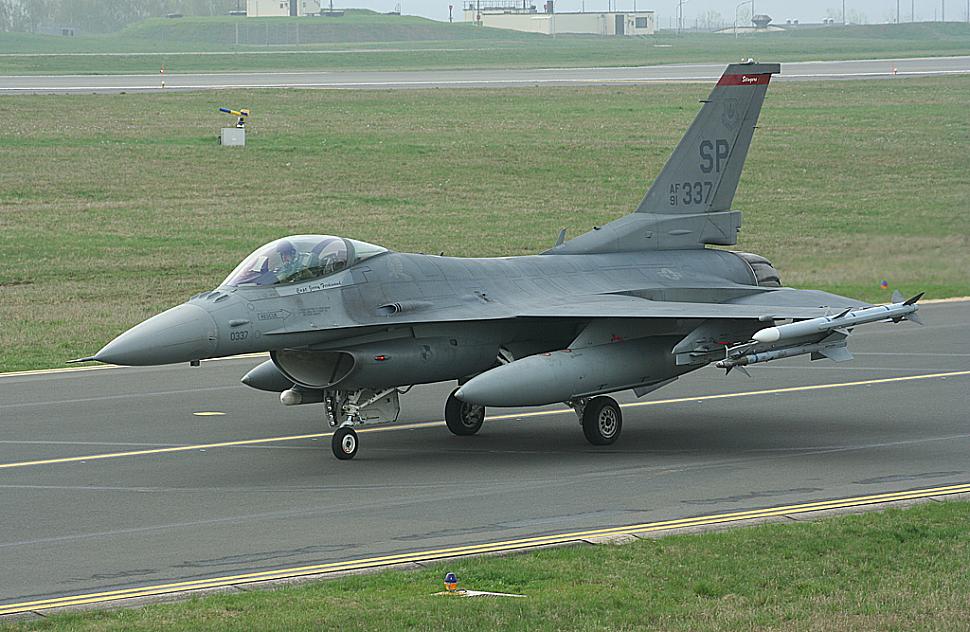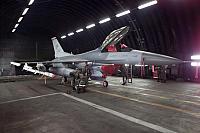Fighter Jet News
F-16 Fighting Falcon News
Pilot error cause of F-16 accident near Spangdahlem
December 18, 2006 (by
Scott Schonauer) -
An investigation into September's F-16 crash near Spangdahlem Air Base has blamed the accident on pilot error.
Investigators determined the jet clipped an airfield antenna while trying to make a landing on Sept. 14, causing a landing gear malfunction and forcing the pilot to safely bail out before the plane crashed. The jet plowed into a grassy field four miles north of the base.
The accident investigation board's final report has not been released to the public, but the Air Force issued on Monday a four-page press release that summarized the study's findings.
Although pilot 1st Lt. Trevor Merrell had a "momentary lapse of attention" on his final turn, the board concluded that a "visual illusion" of the southwest end of Spangdahlem's runway contributed.
Spangdahlem's airfield has known visual illusions that are uncommon to most Air Force bases. The approach at the southwest end has upslope, making the pilot think he is approaching the runway too high, the board said.
"This results in being 'drug-in,'" the release said. "Furthermore a valley, prior to the end of the runway, exaggerates this particular visual illusion."
Merrill, 28, who was assigned to the 22nd Fighter Squadron at the time of the crash, also wasn't familiar with that runway. The base's other runway is downsloping and more commonly used.
Merrell was in a four-ship formation on a routine training mission before the aircraft struck the antenna 15 inches below the top of the pole and the jet crashed just outside the village of Oberkail.
The board, led by Col. Peter Davidson of Ramstein Air Base, found the controlled bailout was done within procedures, resulting in no injuries or loss of life while minimizing damage on the ground.
As a result of the accident and the board's recommendations, the Air Force has made changes in coordination with the German Ministry of Defense and government officials. They include:
Timeline: F-16 crash
On Sept. 14, a Spangdahlem, Germany, F-16 (#91-0337) crashed into a field four miles north of the base. An accident investigation board determined that the pilot collided with an airfield antenna, damaging the fighter's landing gear to the point that the pilot had to perform a controlled bailout and ditch the plane. Here is the sequence of events of the accident, according to the accident investigation board:
The accident investigation board's final report has not been released to the public, but the Air Force issued on Monday a four-page press release that summarized the study's findings.
Although pilot 1st Lt. Trevor Merrell had a "momentary lapse of attention" on his final turn, the board concluded that a "visual illusion" of the southwest end of Spangdahlem's runway contributed.
Spangdahlem's airfield has known visual illusions that are uncommon to most Air Force bases. The approach at the southwest end has upslope, making the pilot think he is approaching the runway too high, the board said.
"This results in being 'drug-in,'" the release said. "Furthermore a valley, prior to the end of the runway, exaggerates this particular visual illusion."
Merrill, 28, who was assigned to the 22nd Fighter Squadron at the time of the crash, also wasn't familiar with that runway. The base's other runway is downsloping and more commonly used.
Merrell was in a four-ship formation on a routine training mission before the aircraft struck the antenna 15 inches below the top of the pole and the jet crashed just outside the village of Oberkail.
The board, led by Col. Peter Davidson of Ramstein Air Base, found the controlled bailout was done within procedures, resulting in no injuries or loss of life while minimizing damage on the ground.
As a result of the accident and the board's recommendations, the Air Force has made changes in coordination with the German Ministry of Defense and government officials. They include:
- Removing the far field antenna and adding new training requirements.
- Due to concerns by residents of the crash site being so close to the village, the Air Force is looking at an alternative spot to safely ditch aircraft in a similar situation. The Air Force plans to use the Baumholder Range as the primary bailout area for aircraft and to jettison fuel.
- A comprehensive review of how the Air Force notifies local emergency crews also is being conducted. An aircraft accident response exercise with local emergency responders is scheduled for January, the release said.
- The release did not mention whether any administrative action was or will be taken against Merrell. While the accident was Merrell's fault, the board president said the pilot's mistakes were not "highly uncommon for an average pilot with his experience."
Timeline: F-16 crash
On Sept. 14, a Spangdahlem, Germany, F-16 (#91-0337) crashed into a field four miles north of the base. An accident investigation board determined that the pilot collided with an airfield antenna, damaging the fighter's landing gear to the point that the pilot had to perform a controlled bailout and ditch the plane. Here is the sequence of events of the accident, according to the accident investigation board:
- 12.45h: The aircraft impacted the far field monitor
- 12.46h: Base controllers notified German Air Traffic Control at Langen of the emergency aircraft
- 13.01h: Base controllers notified Langen of the possibility of ejection
- 13.05h: The pilot ejected from the aircraft
- 13.05h: Langen notified the Rescue Coordination Center at Muenster
- 13.06h: The aircraft impacted the ground
- 13.10h: Muenster RCC notified the local rescue center in Trier
- 13.10h: Trier Rescue Center contacted local fire stations with responsibility in the crash site area
- 13.10h: An ADAC helicopter from Wittlich was notified
- 13.16h: Spangdahlem Air Base fire and medical personnel were on scene with the pilot
- 13.17h: ADAC helicopter arrived on scene at the impact site
- 13.19h: Local emergency responders discovered the impact site
- 13.30h: Spangdahlem Air Base fire department arrived at the impact site
Published on December 19, 2006 in the European edition of Stars and Stripes.
Used with permission from Stars and Stripes, a DoD publication.
© 2006 Stars and Stripes.
Additional images:
Related articles:
Forum discussion:
Tags
- F-16 pilot reported landing gear problem before crash near Spangdahlem (2006-09-17)
- Spangdahlem based F-16C crashes (2006-09-14)
- F-16 Fighting Falcon news archive
Forum discussion:
- One of ours (Spangdahlem) down - Pilot ok ( 58 replies)
Tags


